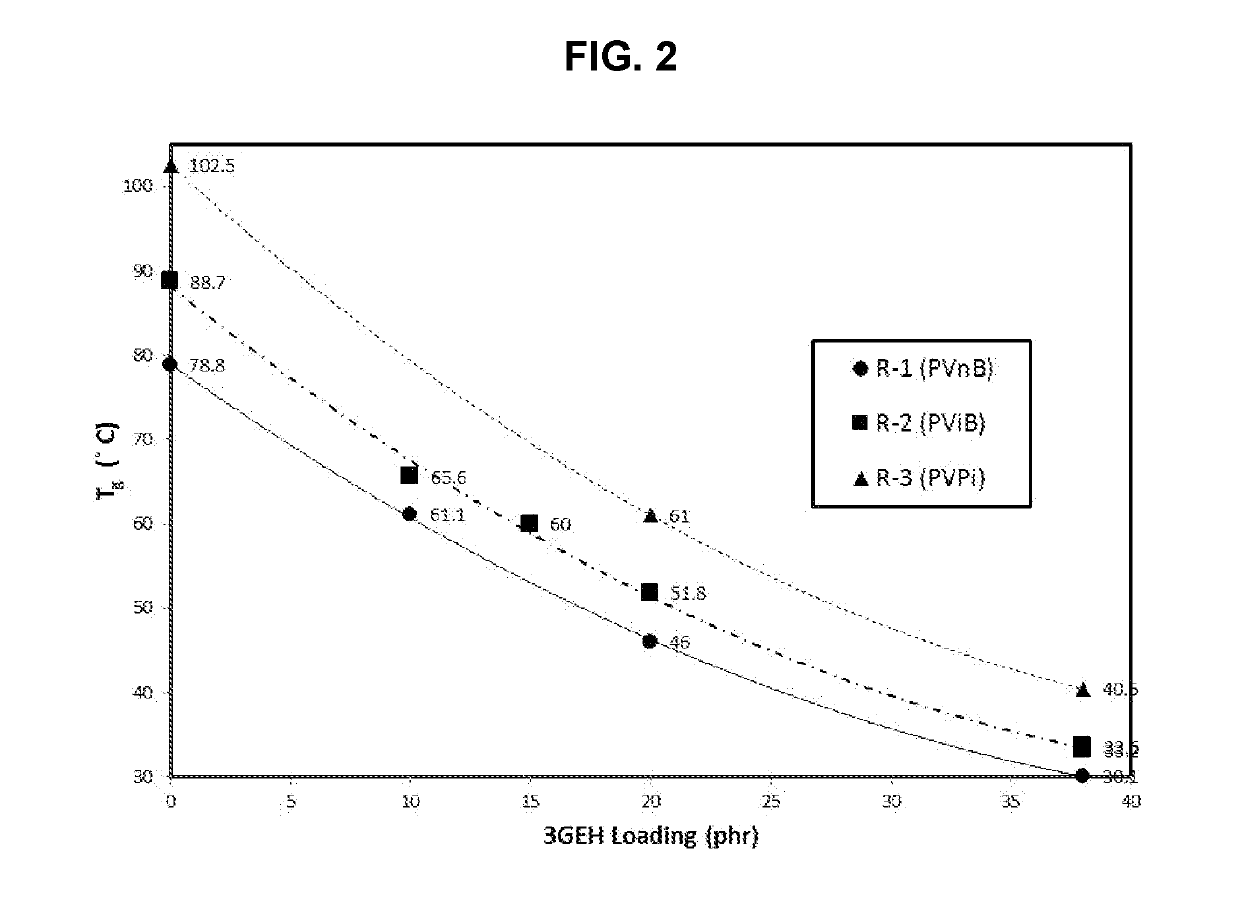Poly(vinyl acetal) resin compositions, layers, and interlayers having enhanced properties
- Summary
- Abstract
- Description
- Claims
- Application Information
AI Technical Summary
Benefits of technology
Problems solved by technology
Method used
Image
Examples
example 1
[0091]Several pure and mixed poly(vinyl acetal) resins were made using conventional lab techniques using 5 L or 12 L glass or high pressure Parr reactors. Poly(vinyl alcohol) solution was prepared by dispersing the poly(vinyl alcohol) powder of the required molecular weight and molecular weight in water at ambient temperature followed by heating the slurry up to greater than 90° C. The poly(vinyl alcohol) is commercially available as a fine white powder from various suppliers, or alternatively it may be produced for captive consumption upstream in the process via hydrolysis of poly(vinyl acetate). The solution formed was initially held at the elevated temperature for a minimum of 30 minutes to ensure complete dissolution of all poly(vinyl alcohol) particles. The aldehyde (n-butyraldehyde, i-butyraldehyde or pivalaldehyde (also referred to as 2,2-dimethylpropanal and trimethylacetaldehyde)) was charged at the desired ratio along with a catalyst. Upon addition of the aldehyde and the ...
example 2
[0101]Additional resins and interlayers were prepared in the same way as described in Example 1 to provide formulations that can improve interlayer stiffness (as measured by Tg and G′) over wide ranges of temperatures and load durations, especially compared to conventional interlayers such as Saflex® DG structural interlayer. Poly(vinyl acetal) polymers with high residual hydroxyl content and shorter acetyl pendant groups can result in stiffer resins and interlayers, and particularly polymers having very high residual hydroxyl levels (at least 24 weight percent or more).
[0102]Three control interlayers (using resins made from PVnB) and five disclosed interlayers (using resins made from PViB) were produced. Sample S-1 was a sample of Saflex® DG41 interlayer that was cut from a commercial roll. The resin type (residual hydroxyl level) and amount of plasticizer are shown in Table 2 below. Each of the interlayers was tested for G′ over a range of temperatures, Tg and Loss Factor at Tg. R...
example 3
[0113]Several mixed poly(vinyl acetal) resins were prepared in a similar manner as described in Example 1 above. The residual hydroxyl content of the resulting mixed poly(vinyl acetal) resins was determined using both FTIR and the titration methods described above. All resins had a residual acetate content of about 2 weight percent.
[0114]Resin R-11 was a standard commercial grade poly(vinyl n-butyral) polymer resin with a residual hydroxyl level of approximately 18.7 weight percent made from medium molecular weight PVOH. Resin R-21 was poly(vinyl i-butyral) resin having a residual hydroxyl level of about 18.7 weight percent made from a 95:5 blend of medium and low molecular weight PVOH and lightly cross-linked. Resin R-31 was made by making multiple small batches having residual hydroxyl levels ranging from about 21.7 to 23.3 weight percent and then blending the resins to form a composite sample having a residual hydroxyl level of about 21.8 weight percent. Resin R-41 was a commerci...
PUM
| Property | Measurement | Unit |
|---|---|---|
| Temperature | aaaaa | aaaaa |
| Temperature | aaaaa | aaaaa |
| Percent by mass | aaaaa | aaaaa |
Abstract
Description
Claims
Application Information
 Login to View More
Login to View More - R&D
- Intellectual Property
- Life Sciences
- Materials
- Tech Scout
- Unparalleled Data Quality
- Higher Quality Content
- 60% Fewer Hallucinations
Browse by: Latest US Patents, China's latest patents, Technical Efficacy Thesaurus, Application Domain, Technology Topic, Popular Technical Reports.
© 2025 PatSnap. All rights reserved.Legal|Privacy policy|Modern Slavery Act Transparency Statement|Sitemap|About US| Contact US: help@patsnap.com



